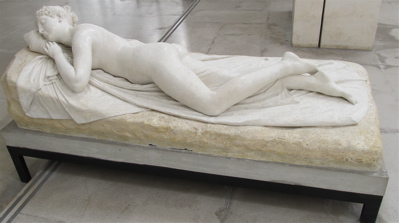Without a doubt it is the Italian neo-classical sculptor Antonio Canova (1757-1822) who grew up and spent a number of years in the hills outside of Venice, specifically in the town of Possagno. After last week's school trip to Florence, we had a two and a half day weekend where I took the train to the town of Treviso, rented a car and spent a day in the hills around Asolo, one of those towns being Possagno, and the Canova museum and Gipsoteca (a building to house sculpture). This post, for those of you uninterested in sculpture can probably be skipped.
The museum is located here in the house in which Canova lived had had a studio.
This gipsoteca was built to house many of the plaster casts that were used to actually make the marble statues. Although the marbles are in art collections around the world (for some reason many at the Hermitage in St. Petersburg) it's cool to see his body of work all in one place.
This is the piece of his that I saw first back in Art History class, Pauline Bonaparte, which is in the Galleria Borghese in Rome.
It's amazing the amount of detail (I remember being impressed by the folds in the couch) is included and how real marble can be made to look like the real thing.
Here's a self-portrait bust of Canova. The black dots are actually nails that are put into the plaster casts used to measure distance and curvature to transfer the cast to the real marble. Interesting fact, the Canova's right hand is preserved and kept at the Accademia in Venice!
One of the pieces I was shocked to see was George Washington. It seemed odd that an American subject would be created by this Italian sculptor. However, looking at the dates, they were contemporaries so it makes sense.
Here's a close up of the tablet Washington is holding, it says "popolo degli Stati Uniti" or "people of the United States"
This is the "crying lion" dedicated to Pope Clement XIII.
There is a "roaring lion" as well. Both are located in St. Peters in the Vatican.
Canova was commissioned for a great number of religious pieces, but I don't find them as interesting as his sculptures of "heros" of the mythical world. Here's the COLOSSAL (you can see the edge of the top of the wall) Hercules and Lichas.
The boxer Damoxenos......
....facing the boxer Creugas.
Probably one of my favorites, "Theseus defeating the Minotaur"
"Triumphant Perseus"
"Ajax"
Another one of Canova's most famous "The Three Graces"
"The Three Graces" comes from the fun, dance and love series of sculptures.
"The Sleeping Nymph"
"The Venus Italica", Canova's Italian interpretation Aphrodite.
"Venus putting a garland on Adonis"
"Cupid and Psyche" I like this one and the last one because it's the female showing affection towards the male.
"Baby and Harp", a table centerpiece and one of the few actual marbles in Possagno
I like this one because it shows Canova at work sculpting non-ideal figures.
"Sleeping Endymione". I love the story behind it. Selene (Moon) loved the Greek God Endymione and every night while he was sleeping, steal a kiss from him. Zeus granted Endymione eternal youth and eternal sleep so Selene would find him every night. His dog sits faithfully waiting for his master to wake up.
Just a note on Canova and neo-classicism. Canova returned to the idealism/realism and classicism after the Baroque/Rococo periods where being "floofy" as I call it was the rage. The Greeks and this neo-classicism is certainly more my style.
Just a note on Canova and neo-classicism. Canova returned to the idealism/realism and classicism after the Baroque/Rococo periods where being "floofy" as I call it was the rage. The Greeks and this neo-classicism is certainly more my style.
























No comments:
Post a Comment